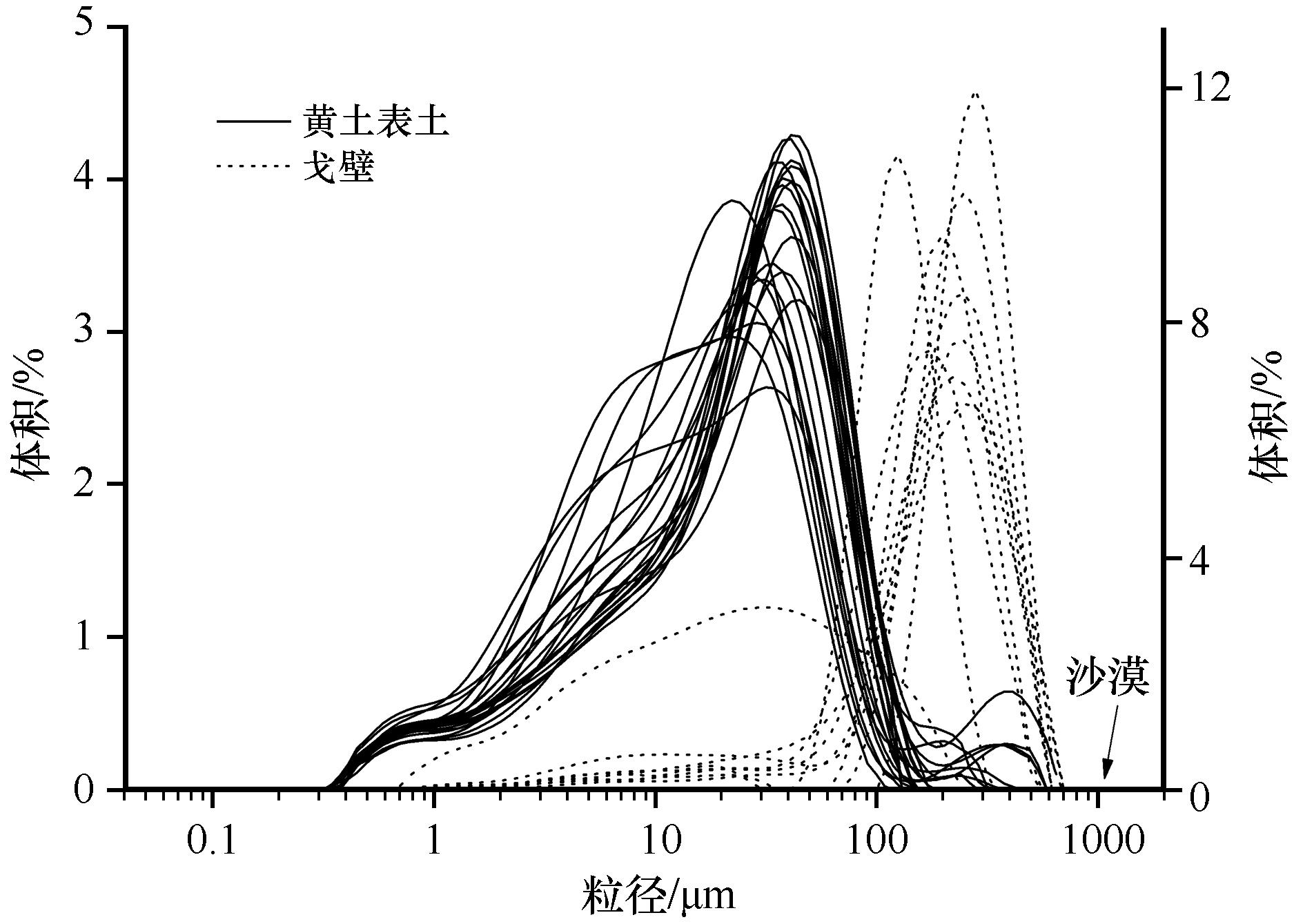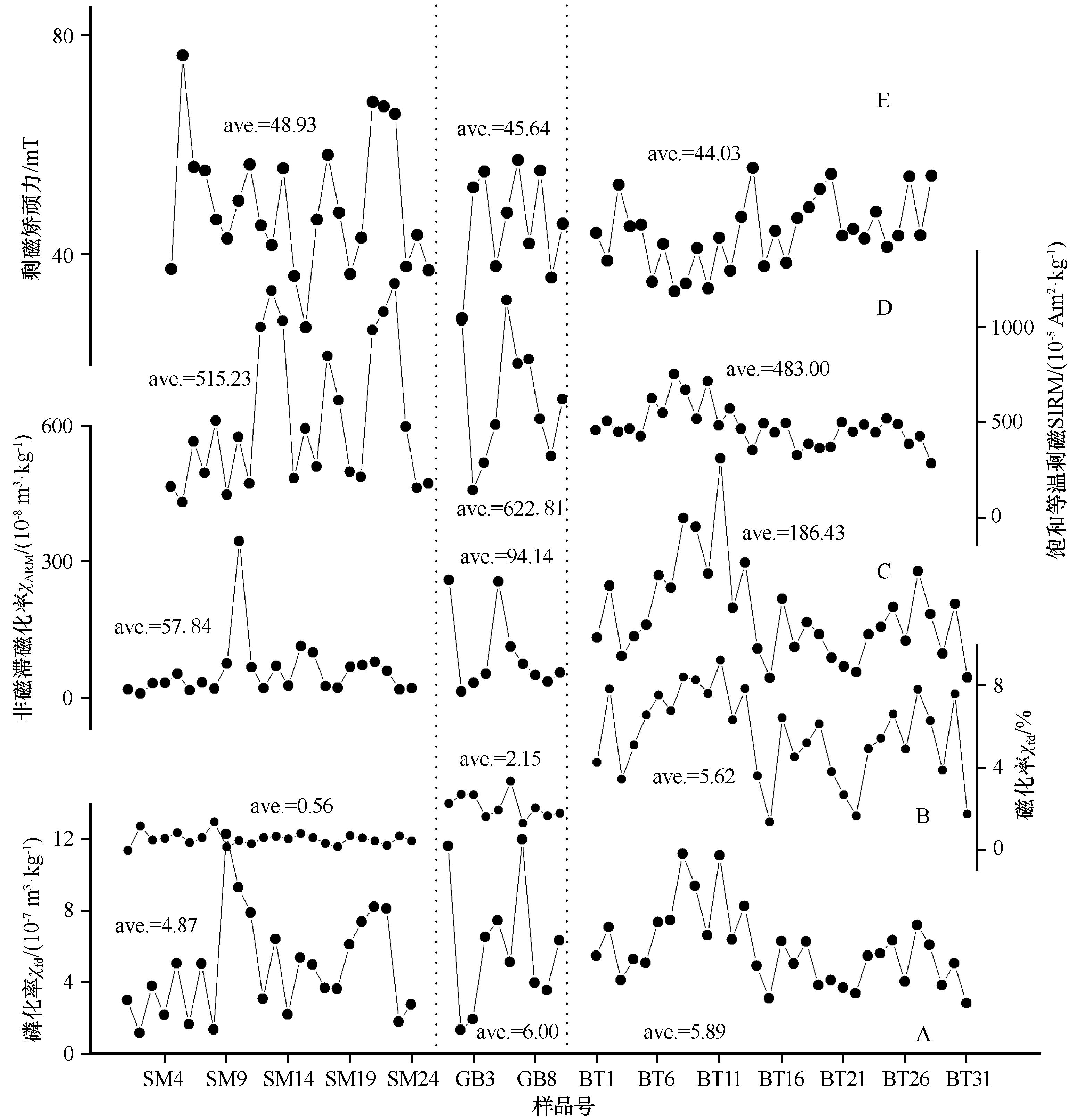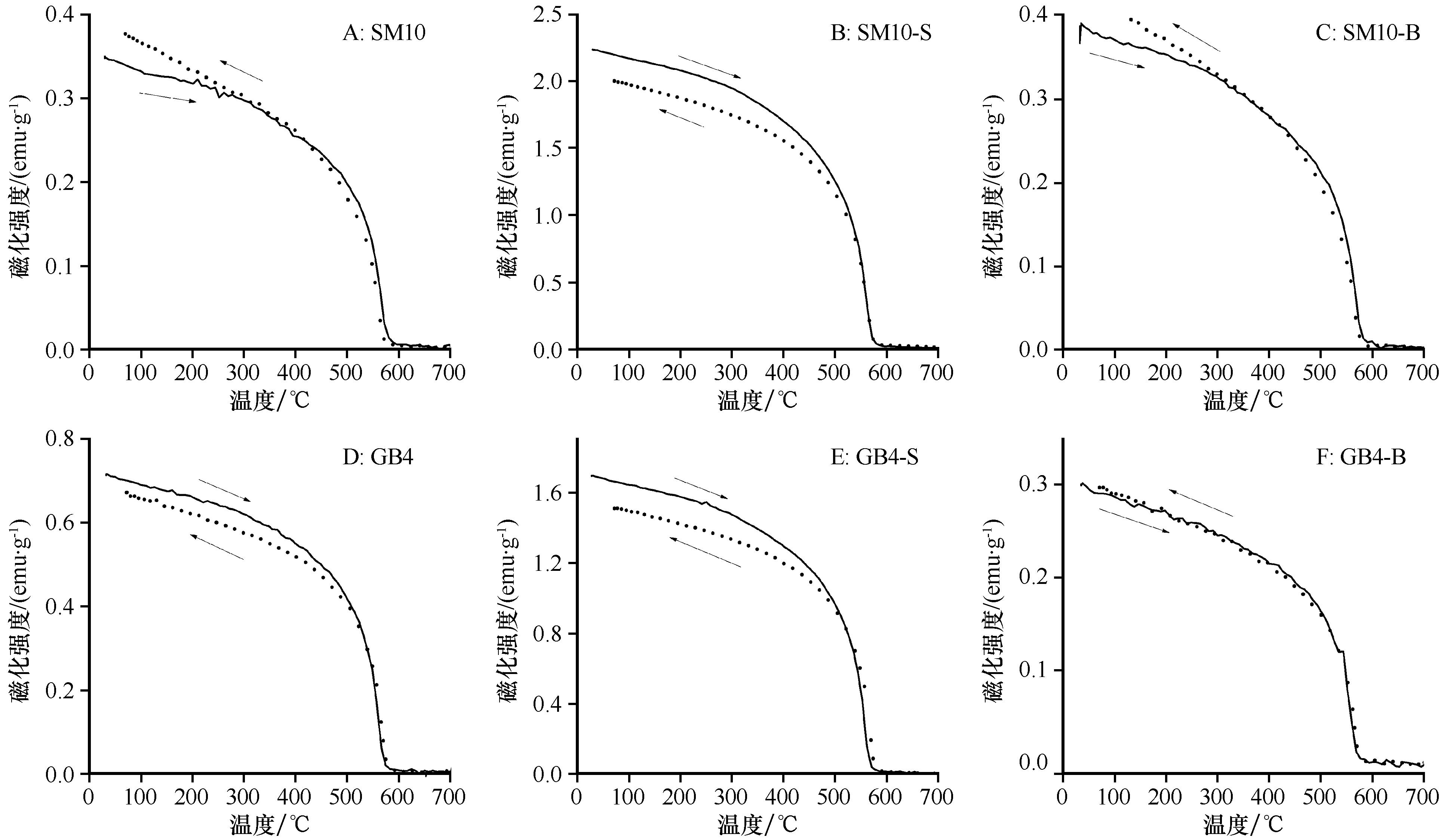
- CN 62-1070/P
- ISSN 1000-694X
- Bimonthly 1981

Journal of Desert Research ›› 2022, Vol. 42 ›› Issue (2): 183-193.DOI: 10.7522/j.issn.1000-694X.2021.00097
Xuegang Mao1,2( ), Lijuan Zhao1(
), Lijuan Zhao1( )
)
Received:2021-04-21
Revised:2021-07-29
Online:2022-03-20
Published:2022-03-30
Contact:
Lijuan Zhao
CLC Number:
Xuegang Mao, Lijuan Zhao. Rock magnetic properties of deserts, gobi and loess topsoils and their implications in models of magnetic susceptibility[J]. Journal of Desert Research, 2022, 42(2): 183-193.
Add to citation manager EndNote|Ris|BibTeX
URL: http://www.desert.ac.cn/EN/10.7522/j.issn.1000-694X.2021.00097

Fig.2 The particle size distributions of Gobi and loess topsoil. The particle size of deserts is greater than 1 000 μm, not measured using Masters2000

Fig. 3 Room temperature magnetic parameters of deserts, Gobi and loess topsoil. The dashed lines delimit the samples of desert, Gobi and loess. SM1-SM24 are desert samples. GB1-GB10 are Gobi samples. BT1-BT31 are loess samples. Ave. represents mean of magnetic parameters

Fig.5 Thermomagnetic curves of typical desert sample (SM10) and gobi sample (GB4). The solid line is heating curve and the dashed line is cooling curve. The left panels are for bulk samples, middle panels (<100 μm) for fine subsamples and right panels for coarse (>100 μm) subsamples

Fig.7 Hysteresis loops of typical gobi (GB4), desert (SM10) and loess (BT1) samples. The-S represents fine (<100 μm) subsamples and -B represents coarse (>100 μm) subsamples
| 样品 编号 | 磁化强度 Ms /(10-3Am2/kg) | 剩余磁化 强度Mrs /(10-5Am2/kg) | 矫顽力 Bc/mT | 剩余 矫顽力 Bcr/mT |
|---|---|---|---|---|
| GB4 | 1.02 | 6.68 | 6.48 | 37.80 |
| GB4-S | 2.42 | 15.80 | 7.16 | n.a. |
| GB4-B | 0.42 | 3.00 | 5.49 | n.a. |
| SM10 | 0.49 | 4.41 | 8.41 | 49.71 |
| SM10-S | 3.00 | 17.50 | 5.60 | n.a. |
| SM10-B | 0.53 | 6.31 | 10.98 | n.a. |
| BT1 | 0.05 | 0.66 | 8.25 | 43.87 |
Table 1 Hysteretic parameters of typical Gobi (GB4), desert (SM10) and loess (BT1) samples. The-S represents fine (<100 μm) subsamples and-B represents coarse (>100 μm) subsamples
| 样品 编号 | 磁化强度 Ms /(10-3Am2/kg) | 剩余磁化 强度Mrs /(10-5Am2/kg) | 矫顽力 Bc/mT | 剩余 矫顽力 Bcr/mT |
|---|---|---|---|---|
| GB4 | 1.02 | 6.68 | 6.48 | 37.80 |
| GB4-S | 2.42 | 15.80 | 7.16 | n.a. |
| GB4-B | 0.42 | 3.00 | 5.49 | n.a. |
| SM10 | 0.49 | 4.41 | 8.41 | 49.71 |
| SM10-S | 3.00 | 17.50 | 5.60 | n.a. |
| SM10-B | 0.53 | 6.31 | 10.98 | n.a. |
| BT1 | 0.05 | 0.66 | 8.25 | 43.87 |
| 1 | 刘东生 等.黄土与环境[M].北京:科学出版社,1985. |
| 2 | Meijer N, Dupont-Nivet G, Licht A,et al.Identifying eolian dust in the geological record[J].Earth-Science Reviews,2020,211:102853. |
| 3 | Li Y, Shi W, Aydin A,et al.Loess genesis and worldwide distribution[J].Earth-Science Reviews,2020,201:102947. |
| 4 | Maher B A.Palaeoclimatic records of the loess/palaeosol sequences of the Chinese Loess Plateau[J].Quaternary Science Reviews,2016,154:23-84. |
| 5 | Song Y, Yang S, Nie J,et al.Quaternary paleoclimate and paleoenvironmental changes in Central Asia[J].Palaeogeography,Palaeoclimatology,Palaeoecology,2021,568:110319. |
| 6 | Sun Y, Yan Y, Nie J,et al.Source-to-sink fluctuations of Asian aeolian deposits since the late Oligocene[J].Earth-Science Reviews,2020,200:102963. |
| 7 | Guo Z T, Ruddiman W F, Hao Q Z,et al.Onset of Asian desertification by 22 Myr ago inferred from loess deposits in China[J].Nature,2002,416(6877):159-163. |
| 8 | 杨杰东,李高军,戴澐,等.黄土高原黄土物源区的同位素证据[J].地学前缘,2009,16(6):195-206. |
| 9 | 李高军,车旭东,肖国桥,等.西宁黄土碎屑锆石年龄特征及其对黄土高原黄土物源的指示意义[J].第四纪研究,2013,33(2):345-350. |
| 10 | Jia J, Wang Y J, Xia D S,et al.Dust sources of Last Glacial Chinese loess based on the iron mineralogy of fractionated source samples[J].Geophysical Research Letters,2019,46(4):2103-2110. |
| 11 | 孙继敏.黄土沉积与地球圈层相互作用[J].第四纪研究,2020,40(1):1-7. |
| 12 | 张小曵.亚洲粉尘的源区分布释放、输送、沉降与黄土堆积[J].第四纪研究,2001,21(1):29-40. |
| 13 | 赵景波.西安刘家坡第1、第5层古土壤研究[J].地理研究,1991,10(4):51-58. |
| 14 | Chlachula J.The Siberian loess record and its significance for reconstruction of Pleistocene climate change in north-central Asia[J].Quaternary Science Reviews,2003,22(18/19):1879-1906. |
| 15 | Begét J E, Stone D B, Hawkins D B.Paleoclimate forcing of magnetic susceptibility variations in Alaskan loess during the late Quaternary [J].Geology,1990,18(1):40-43. |
| 16 | 邓成龙,刘青松,潘永信,等.中国黄土环境磁学[J].第四纪研究,2007,27(2):193-209. |
| 17 | Liu Q, Deng C, Torrent J,et al.Review of recent developments in mineral magnetism of the Chinese loess[J].Quaternary Science Reviews,2007,26(3/4):368-385. |
| 18 | Long X, Ji J, Barrón V,et al.Climatic thresholds for pedogenic iron oxides under aerobic conditions:processes and their significance in paleoclimate reconstruction[J].Quaternary Science Reviews,2016,150:264-277. |
| 19 | 刘青松,邓成龙.磁化率及其环境意义[J].地球物理学报,2009,52(4):1041-1048. |
| 20 | Hu P, Liu Q, Torrent J,et al.Characterizing and quantifying iron oxides in Chinese loess / paleosols:implications for pedogenesis[J].Earth and Planetary Science Letters,2013,369/370:271-283. |
| 21 | Long X, Ji J, Barrón V,et al.Climatic thresholds for pedogenic iron oxides under aerobic conditions:processes and their significance in paleoclimate reconstruction[J].Quaternary Science Reviews,2016,150:264-277. |
| 22 | Balsam W L, Ellwood B B, Ji J,et al.Magnetic susceptibility as a proxy for rainfall:worldwide data from tropical and temperate climate[J].Quaternary Science Reviews,2011,30(19/20):2732-2744. |
| 23 | Orgeira M J, Egli R, Compagnucci R H.A quantitative model of magnetic enhancement in loessic soils[M]//E.Petrovský E,Ivers D,Harinarayana E,et al.The Earth’s Magnetic Interior.Dordrecht,Netherlands:Springer,2011:361-397. |
| 24 | Maher B A, Thompson R.Paleorainfall reconstructions from pedogenic magnetic susceptibility variations in the Chinese Loess and Paleosols[J].Quaternay Research,1995,44:383-391. |
| 25 | Zhou L P, Oldfield F, Wintle A G,et al.Partly pedogenic origin of magnetic variations in Chinese loess[J].Nature,1990,346(6286):737-739. |
| 26 | Heller F, Liu T.Magnetostratigraphical dating of loess deposits in China[J].Nature,1982,300(5891):431-433. |
| 27 | Begét J E, Hawkins D B.Influence of orbital parameters on Pleistocene loess deposition in central Alaska[J].Nature,1989,337(6203):151-153. |
| 28 | Chlachula J, Rutter N W, Evans M E.A late Quaternary loess-palaeosol record at Kurtak,southern Siberia[J].Canadian Journal of Earth Science,1997,34:679-686. |
| 29 | 刘秀铭,夏敦胜,刘东生,等.中国黄土和阿拉斯加黄土磁化率气候记录的两种模式探讨[J].第四纪研究,2007,27(2):210-220. |
| 30 | 刘秀铭,刘东生,夏敦胜,等.中国与西伯利亚黄土磁化率古气候记录:氧化和还原条件下的两种成土模式分析[J].中国科学(D辑),2007,37(10):1382-1391. |
| 31 | Seto Y, Stevens T.Magnetic susceptibility in the European Loess Belt:new and existing models of magnetic enhancement in loess[J].Palaeogeography,Palaeoclimatology,Palaeoecology,2021,569:110329. |
| 32 | Bidegain J C, Evans M E, van Velzen A J.A magnetoclimatological investigation of Pampean loess,Argentina[J].Geophysical Journal International,2005,160(1):55-62. |
| 33 | Bidegain J C, van Velzen A J, Rico Y.The Brunhes/Matuyama boundary and magnetic parameters related to climatic changes in Quaternary sediments of Argentina[J].Journal of South American Earth Sciences,2007,23(1):17-29. |
| 34 | Kemp R A, Toms P S, King M,et al.The pedosedimentary evolution and chronology of Tortugas,a Late Quaternary type-site of the northern Pampa,Argentina[J].Quaternary International,2004,114(1):101-112. |
| 35 | 李平原,刘秀铭,郭雪莲,等.西北戈壁沙漠-黄土高原区表土磁化率特征及其意义[J].第四纪研究,2013,33(2):360-367. |
| 36 | 王涛,刘秀铭,吕镔,等.新疆尼勒克黄土岩石磁学特征及变化机制研究[J].第四纪研究,2014,34(3):491-503. |
| 37 | Sun D, Bloemendal J, Rea D,et al.Grain-size distribution function of polymodal sediments in hydraulic and aeolian environments,and numerical partitioning of the sedimentary components[J].Sedimentary Geology,2002,152(3/4):263-277. |
| 38 | Liu Q, Roberts A P, Larrasoaña J C,et al.Environmental magnetism:principles and applications[J].Reviews of Geophysics,2012,50(4):197-215. |
| 39 | Dunlop D J, Özdemir Ö.Rock Magnetism:Fundamentals and Frontiers[M].Cambridge,UK:Cambridge University,1997. |
| 40 | Fine P, Singer M J, Verosub K L,et al.New evidence for the origin of ferrimagnetic minerals in loess from China[J].Soil Science Society of America Journal,1993,57(6):1537-1542. |
| 41 | 段宗奇,高星,刘青松.非磁滞剩磁(ARM)及其在地学中的应用[J].地球物理学报,2012,27(5):1929-1938. |
| 42 | Dearing J A, Bird P M, Dann R J L,et al.Secondary ferrimagnetic minerals in Welsh soils:a comparison of mineral magnetic detection methods and implications for mineral formation[J].Geophysical Journal International,1997,130(3):727-736. |
| 43 | 刘秀铭, Shaw J,蒋建中,等.磁赤铁矿的几种类型与特点分析[J].中国科学(D辑),2010,40(5):592-602. |
| 44 | Deng C, Zhu R, Jackson M J,et al.Variability of the temperature-dependent susceptibility of the holocene eolian deposits in the Chinese loess plateau:a pedogenesis indicator[J].Physics and Chemistry of the Earth,Part A:Solid Earth and Geodesy,2001,26(11/12): 873-878. |
| 45 | Liu Q, Deng C, Yu Y,et al.Temperature dependence of magnetic susceptibility in an argon environment: implications for pedogenesis of Chinese loess/palaeosols[J].Geophysical Journal International,2005,161:102-112. |
| 46 | Fukuma K, Torii M.Variable shape of magnetic hysteresis loops in the Chinese loess-paleosol sequence[J].Earth,Planets and Space,1998,50(1):9-14. |
| 47 | 孙继敏,许立亮.8 Ma以来黄土高原风尘堆积的物源变化与上地壳演化的关系[J].第四纪研究,2007,27(2):187-192. |
| 48 | 陈渠,刘秀铭, Heller F,等.伊犁黄土磁化率的增减及其成因[J].科学通报,2012,57(24):2310-2321. |
| 49 | 吕镔,刘秀铭,赵国永,等.新疆博乐黄土岩石磁学特征及环境意义[J].兰州大学学报(自然科学版),2012,48(5):1-8. |
| 50 | 宋友桂,史正涛,方小敏,等.伊犁黄土的磁学性质及其与黄土高原对比[J].中国科学(D辑),2010,40(1):61-72. |
| 51 | 贾佳,刘现彬,夏敦胜,等.坎苏剖面记录的西天山地区黄土磁学性质及其控制因素初探[J].干旱区地理,2011,34(1):124-132. |
| 52 | 叶玮.新疆伊犁地区自然环境特点与黄土形成条件[J].干旱区地理,1999,22(3):9-15. |
| 53 | 王勇,潘保田,管清玉,等.西北干旱区黄土-古土壤磁化率变化特征[J].海洋地质与第四纪地质,2008,28(1):111-114. |
| 54 | 刘秀铭,毛学刚,丁仲礼,等.黄土古气候变化趋势与青藏高原隆升关系初探[J].第四纪研究,2009,29(5):988-999. |
| 55 | 李平原,刘秀铭,刘植,等.腾格里沙漠边缘表土磁学性质及其意义[J].第四纪研究,2012,32(4):771-776. |
| 56 | Maher B A, Taylor R M.Formation of ultrafine-grained magnetite in soils[J].Nature,1988,336:368-370. |
| 57 | 刘秀铭,刘植,吕镔,等.塞尔维亚黄土的磁学性质及其环境意义[J].科学通报,2012,57(33):3173-3184. |
| 58 | Maher B A.Magnetic properties of modern soils and quaternary loessic paleosols:paleoclimatic implications[J].Palaeogeography,Palaeoclimatology,Palaeoecology,1998,137(1/2):25-54. |
| 59 | Jia J, Xia D, Wang B,et al.The investigation of magnetic susceptibility variation mechanism of Tien Mountains modern loess:Pedogenic or wind intensity model?[J].Quaternary International,2013,296:141-148. |
| 60 | Iriondo M H, Kröhling D M.Non-classical types of loess[J].Sedimentary Geology,2007,202(3):352-368. |
| 61 | 叶玮.新疆西风区黄土与古土壤磁化率变化特点[J].中国沙漠,2001,21(4):380-386. |
| [1] | Fangming Zeng, Hongpan Xue. The dataset of elemental compositions of the late Pleistocene loess-paleosol deposits on the northeastern Tibetan Plateau [J]. Journal of Desert Research, 2021, 41(6): 262-264. |
| [2] | Rongrong Qiao, Yan Han, Shuxin Ji, Chunyuan Dong, Aojie Wang, Xueli Chang. Analysis of soil erosion in loess area of sandstone based on terrain index [J]. Journal of Desert Research, 2021, 41(5): 175-182. |
| [3] | Ziting Wang, Lei Yang, Guang Li, Chunshan Chai, Yangdong Zhang, Donghao Liu. Distribution and diversity of herbage under Caragana korshinskii plantation at hillslope scale in the semi-arid loess hilly region [J]. Journal of Desert Research, 2021, 41(2): 120-128. |
| [4] | Fangming Zeng, Hongpan Xue. Elemental compositions of the late Quaternary loess-paleosol on the northeastern Qinghai-Tibet Plateau and their implications for provenance [J]. Journal of Desert Research, 2020, 40(6): 105-117. |
| [5] | Du Huirong, Xie Yuanyun, Kang Chunguo, Chi Yunping, Wang Jiaxin, Sun Lei. Grain-size and geochemical compositions of the Harbin loess deposits and their implications for eolian dust provenances [J]. Journal of Desert Research, 2020, 40(1): 64-76. |
| [6] | Wang Ziting, Li Guang, Cai Guojun, Chai Chunshan, Zhang Yangdong, Qi Jianli. Response of household income to Grain-for-Green Project in hilly region of Loess Plateau: a case study of Longtan watershed [J]. Journal of Desert Research, 2020, 40(1): 223-232. |
| [7] | Lei Chen, Pang Jiangli, Huang Chunchang, Zha Xiaochun, Zhou Yali, Wen Ruiyan, Chui Yuda. Composition Characteristics and Significance of Rb, Sr and Ba of Fanjiacheng Loess-paleosol Profile in the Upper Reaches of the Weihe River [J]. Journal of Desert Research, 2019, 39(6): 90-98. |
| [8] | Li Jiyan, Zhou Ling, Liu Yi, Zhang Qian, Cai Yingying, Zhang Baogui. Grain-size and Geochemical Element Composition for Topsoil in Northwestern Shanxi, China [J]. Journal of Desert Research, 2019, 39(5): 155-162. |
| [9] | Wen Haiyan, Wu Shujuan, Fu Hua. Influence of Nitrogen Addition on Net Ecosystem Carbon Exchange of Steppe in the Loess Plateau [J]. Journal of Desert Research, 2019, 39(3): 34-40. |
| [10] | Han Rui, Su Zhizhu, Li Xiang, Liu Miaomiao, Ma Yijuan. Holocene Climate Change Revealed by Grain Size and Magnetic Susceptibility in the Eastern Mu Us Sandy Land [J]. Journal of Desert Research, 2019, 39(2): 105-114. |
| [11] | Sun Lifan, Shi Xingmin, Wang Lu. Assessments of the Efficacy of Farmers' Adaptive Behaviors to Climate Change [J]. JOURNAL OF DESERT RESEARCH, 2018, 38(2): 428-436. |
| [12] | Wang Youjun, Jia Jia, Gao Fuyuan, Lu Hao, Liu Hao, Xia Dunsheng. Magnetic Characteristics of Aeolian Sand and Ancient Underwater Sediments and Their Implications in Alxa Region of China [J]. JOURNAL OF DESERT RESEARCH, 2017, 37(4): 626-634. |
| [13] | Lyu Anqi, Lu Huayu, Zeng Lin, Yi Shuangwen, Zhuo Haixin, Xu Zhiwei, Zhang Wenchao. Evolution of Horqin and Otindag Dune Fields since 1.08 Ma Recorded by Grain Size of Loess in Chifeng,Northeastern China [J]. JOURNAL OF DESERT RESEARCH, 2017, 37(4): 659-665. |
| [14] | Yang Fan, Jin Heling, Li Xiaoze, Geng Jianwei, Liu Bing. Climate Change in the Southeastern Mu Us Sandy Land in Middle and Late Holocene [J]. JOURNAL OF DESERT RESEARCH, 2017, 37(3): 431-438. |
| [15] | Wang Bin, Zeng Lin, Zhao Wancang, Zhang Wenfang, Duan Keqin. New Research Progress of the Transport Dynamics and the Accumulation Factor of the Aeolian Dust in Chinese Loess Plateau [J]. JOURNAL OF DESERT RESEARCH, 2017, 37(2): 237-246. |
| Viewed | ||||||
|
Full text |
|
|||||
|
Abstract |
|
|||||
©2018Journal of Desert Research
Tel:0931-8267545
Email:caiedit@lzb.ac.cn;desert@lzb.ac.cn
Support:Magtech